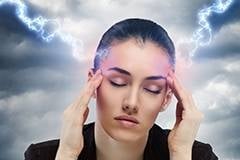Aura: Warning Sign of a Migraine…
and a Future Stroke
Medically Reviewed by Timothy L. Hagen, DO
Excruciating pain. Nausea. Sensitivity to light. The crushing symptoms of migraine headaches affect 15% of the population and, unfortunately, women are 3 times as likely as men to experience them.
Migraine headaches alone are bad enough. But add the symptoms related to “auras” and your risk of a future stroke goes up significantly.
AURA
A migraine headache with aura, known as a “classical migraine,” affects up to 30% of migraine sufferers. Five to 20 minutes before the onset of the headache, you see flashing lights, sparks, and dark patches. These effects might be accompanied by the feeling of pins and needles, spreading from one part of your body to another.
In some ways the aura is a good thing. Longtime sufferers recognize the aura as a warning sign of an oncoming migraine. It allows the victim to prepare, taking medication to reduce the severity of the migraine.
The migraine with aura should also be seen as a warning sign of possible stroke and heart problems.
WHAT IS THE RISK?
First, the good news: In most people, migraines rarely result in a stroke. Evidence says it’s also unlikely that a stroke will occur during a migraine.
The not-so-good news: People who suffer migraines (even without aura) are more likely to eventually have some type of heart or vascular problem. A cause-and-effect hasn’t been proven. In other words, the migraine with aura doesn’t CAUSE the stroke. But the two do occur together.
Migraine with aura signals a doubling in the stroke risk for the individual.
- The risk is higher in women (especially those on oral contraceptives) than men,
- Higher for people under age 45 and
- Higher for smokers.
Migraine accompanied by the aura raises your risk higher than any other predictor of future stroke and heart problems than high blood pressure,
WHAT YOU CAN DO
“We really don’t know if the migraine with aura is a modifiable risk factor for future stroke and cardiovascular problems,” says McLeod Neurologist Dr. Timothy Hagen. “Since you can’t reduce the risk related to aura, a migraine sufferer should focus on reducing all your other stroke and cardiovascular risks, such as high blood pressure, obesity, high cholesterol.”
Here are some articles that can help you with those risk factors for heart disease and stroke that you can change:
Lower is Better: Blood Pressure and Other Heart Risks
The Path to a Heart Healthy Weight: Exercise, Heart Healthy Diet
French Fries Are Not a Vegetable: The Start to a Heart Healthy Diet
High Blood Pressure – Shortcut to Heart Attack or Stroke
Sources include: McLeod Health, American Headache Society, National Institutes of Health, Stroke Association (UK), Women’s Health Study, American Academy of Neurology
-
McLEOD REGIONAL MEDICAL CENTER FLORENCE
843-777-2000 -
McLEOD DARLINGTON
843-777-1100 -
McLEOD DILLON
843-774-4111 -
McLEOD LORIS
843-716-7000 -
McLEOD SEACOAST
843-390-8100 -
McLEOD CHERAW
843-537-7881 -
McLEOD CLARENDON
803-433-3000



-
McLEOD REGIONAL MEDICAL CENTER FLORENCE
843-777-2000 -
McLEOD DARLINGTON
843-777-1100 -
McLEOD DILLON
843-774-4111 -
McLEOD LORIS
843-716-7000 -
McLEOD SEACOAST
843-390-8100 -
McLEOD CHERAW
843-537-7881 -
McLEOD CLARENDON
803-433-3000
 Find a Doctor
Find a Doctor  Locations
Locations  Services
Services 